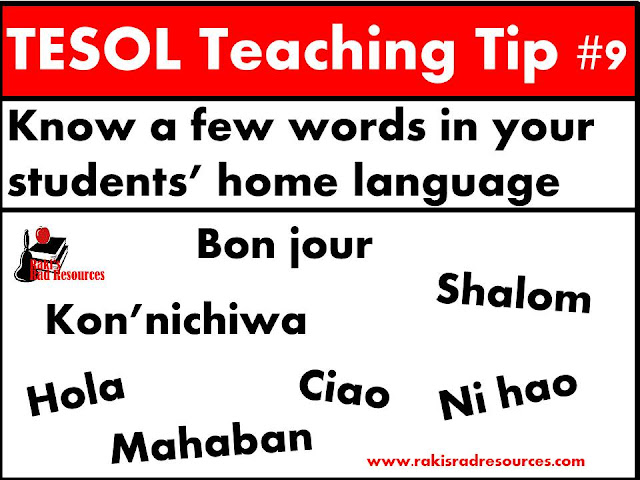My class consists of 19 students, of which only 1 speaks English only in his household, and even he began his life in a bilingual environment. The other 18 speak at least one, if not two other languages in their homes. Most of my students speak Arabic, but many also speak French. I have 3 who speak French and not Arabic, 1 who speaks Spanish, and 1 who speaks a Philippine dialect. All of my students speak SOME English, but to varying degrees. My job is to teach them English, while also teaching them everything we normally teach in school (reading, writing, math, science, social studies etc.) Fortunately, I am certified to teach ESL and have some experience with English Language Learners. Due to my unique teaching position, I have had some readers ask for tips on teaching English Language Learners. So, from now on, I will now be doing a Teaching Tip Tuesday geared especially towards teaching English Language Learners. Here’s this week’s Tuesday TESOL Teaching Tip:
ELL Teaching Tip #9: Know A Little of Your Students’ Home Language
There is a lot of debate about whether or not to translate for English Language Learners. I am not writing this to enter this debate. My position is simply one of convenience and common sense. In my experience, it is helpful to know at least a little bit of your students’ home language. This tip explains why it’s important to know some words in your students’ home language and how to learn some of those words if you don’t already know them.
*** There are some classrooms where this tip will not be helpful. For example, some classrooms contain students from 3 or 4 different home languages, which will make this impossible. However, in most classrooms, your English Language Learners will mostly speak 1 or 2 languages, and this is the home language I suggest you learn these key words in. ***
Words to Know
There are certain times where students NEED to learn the word in English. There are other times, where students just NEED to understand what’s going on. For this reason, I try to make sure I know the following words in every language possible: Sit Down, Stop, Come Here, Quiet, Talk, Bathroom, Book bag, Pencil, Paper, Good, Bad, Hello, Goodbye, Numbers (at least 1 – 10). More words are better, but these words will at least 1. get you through the first days when there is little language being understood 2. allow you to make yourself clear when all else fails and you just need your student to sit down, or get packed up to go home.

Where to Learn Home Language Words
There are tons of great websites out there to help you learn languages, but my favorite is Pronunciator, which gives you access to 60 different languages and pronounces the words for you. (It also has tutorials in English, if you want to have your ELL students work on it.) Dual Language Dictionaries can also be helpful when trying to communicate with students. Of course, there is also the possibility of using other students who speak the same home language as translators. Choose your peer translators carefully, though, it takes higher level thinking to switch from one language to the next!
Do you want more TESOL Teaching Tips – check back each Tuesday for more. Or, click HERE for other TESOL Teaching Tips.


ELL Teaching Tip #9: Know A Little of Your Students’ Home Language
There is a lot of debate about whether or not to translate for English Language Learners. I am not writing this to enter this debate. My position is simply one of convenience and common sense. In my experience, it is helpful to know at least a little bit of your students’ home language. This tip explains why it’s important to know some words in your students’ home language and how to learn some of those words if you don’t already know them.
*** There are some classrooms where this tip will not be helpful. For example, some classrooms contain students from 3 or 4 different home languages, which will make this impossible. However, in most classrooms, your English Language Learners will mostly speak 1 or 2 languages, and this is the home language I suggest you learn these key words in. ***
Words to Know
There are certain times where students NEED to learn the word in English. There are other times, where students just NEED to understand what’s going on. For this reason, I try to make sure I know the following words in every language possible: Sit Down, Stop, Come Here, Quiet, Talk, Bathroom, Book bag, Pencil, Paper, Good, Bad, Hello, Goodbye, Numbers (at least 1 – 10). More words are better, but these words will at least 1. get you through the first days when there is little language being understood 2. allow you to make yourself clear when all else fails and you just need your student to sit down, or get packed up to go home.

Where to Learn Home Language Words
There are tons of great websites out there to help you learn languages, but my favorite is Pronunciator, which gives you access to 60 different languages and pronounces the words for you. (It also has tutorials in English, if you want to have your ELL students work on it.) Dual Language Dictionaries can also be helpful when trying to communicate with students. Of course, there is also the possibility of using other students who speak the same home language as translators. Choose your peer translators carefully, though, it takes higher level thinking to switch from one language to the next!
Do you want more TESOL Teaching Tips – check back each Tuesday for more. Or, click HERE for other TESOL Teaching Tips.



No comments:
Post a Comment